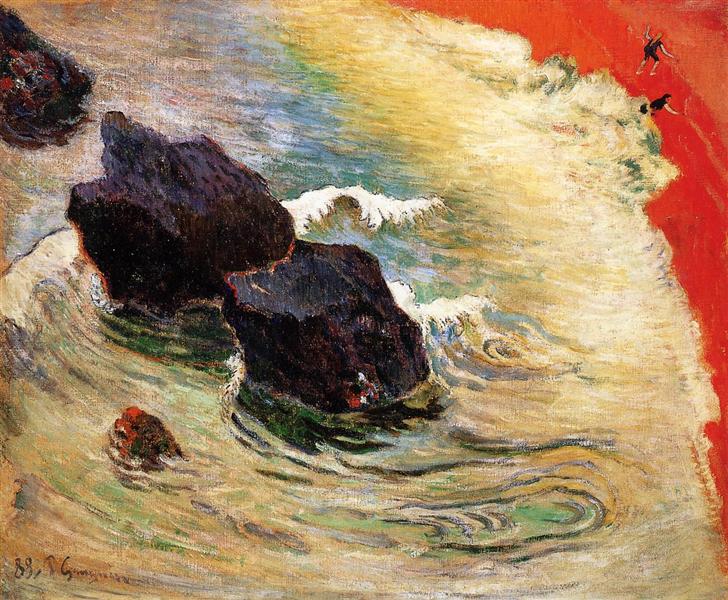Description
The work "La Ola" by Paul Gauguin, painted in 1888, is a clear exponent of symbolism and post -impressionism that would characterize the career of the French artist. Through this painting, Gauguin not only enters the representation of the movement and strength of the ocean, but also explores a palette of vibrant colors that transcends the mere naturalistic representation to enter a world of sensations.
When observing "the wave", it shows immediately how the great dynamism of the wave consumes much of the canvas, creating a sense of immediacy and energy. Water execution is almost palpably visceral, with swirls and foams that reflect not only Gauguin's technical capacity, but also its emotional connection with the element it is representing. This representation of water moves away from a strictly realistic approach, flowing towards a more subjective aesthetic, where color and shape become expression vehicles. The wave, painted in shades of deep and greenish blue, highlights the sway and the strength of nature, inviting the viewer to immerse himself in his turbulence.
The horizon, clearly outlined by a sky that is getting dark to the bottom, is populated by clouds that bring drama to the environment. This interaction between the sky and the sea suggests a dynamic scene in constant movement. The curvilinear forms of the wave work in Tandem with the horizon lines, creating a visual tension that feels almost musical. In this context, Gauguin's work departs from the most refined symbolism to go to a representation that seeks to injust the viewer an almost tactile experience.
Although "the wave" does not include human characters, the lack of these does not remain intimacy to the work. Instead, there is a deep respect for the texture and vaporosity of water, which translate into a way of honoring nature. The absence of human figures allows the viewer to concentrate completely on the natural element, thus experiencing a more direct connection with the sublime.
The use of color in "the wave" is particularly attractive and represents a clear advance towards the search for its own plastic language, very in the line of other contemporary works of Gauguin. Through the use of exaggerated and contrasting tones, the artist manages to evoke not only the light and intensity of the scene, but also a mood that can be interpreted in multiple ways. The vibrant colors that are intertwined with the forms remind their subsequent works, in which color dramatization would be used as a means to explore deeper issues about life, mythology and identity.
Gauguin, whose artistic search led him to Tahiti and a more radical exploration of symbolization, already showed in "the wave" his interest in elements that challenged conventions. This approach would be bolder in works such as "Where do we come from? What are we?
Thus, "the wave" not only represents Gauguin's technical mastery, but also his emerging artistic philosophy. The work invites us to reflect on the relationship of the human being with the powerful elements of nature, evoking deep sensations that resonate in the viewer's aesthetic experience. "The wave" is ultimately a testimony of the development of an artist who, through his commitment to painting, sought to capture emotions and concepts that would transcend time and space, solidifying his legacy in the Canon of Art.
KUADROS ©, a famous paint on your wall.
Hand-made oil painting reproductions, with the quality of professional artists and the distinctive seal of KUADROS ©.
Reproduction service paintings With a guarantee of satisfaction. If you are not completely satisfied with the replica of your painting, we refund your money 100%.

